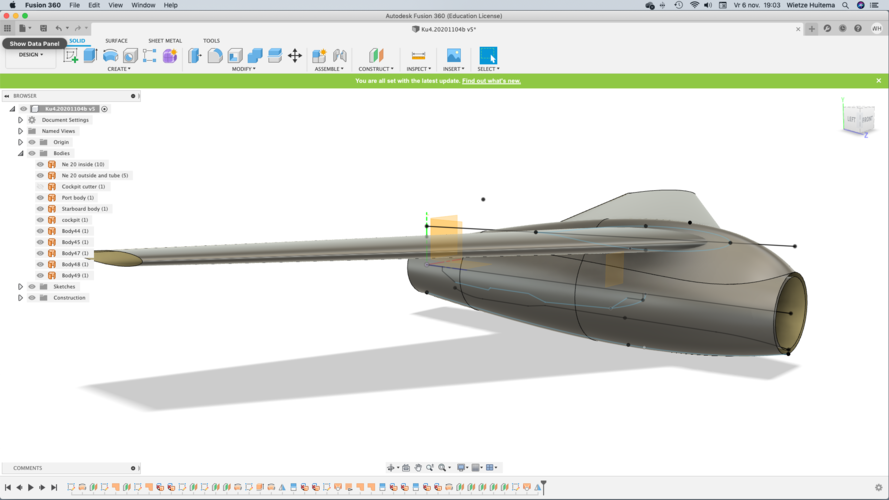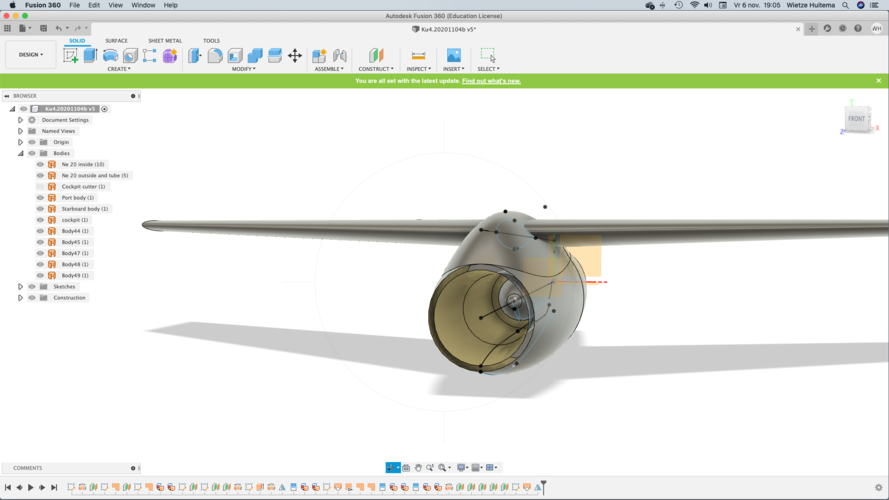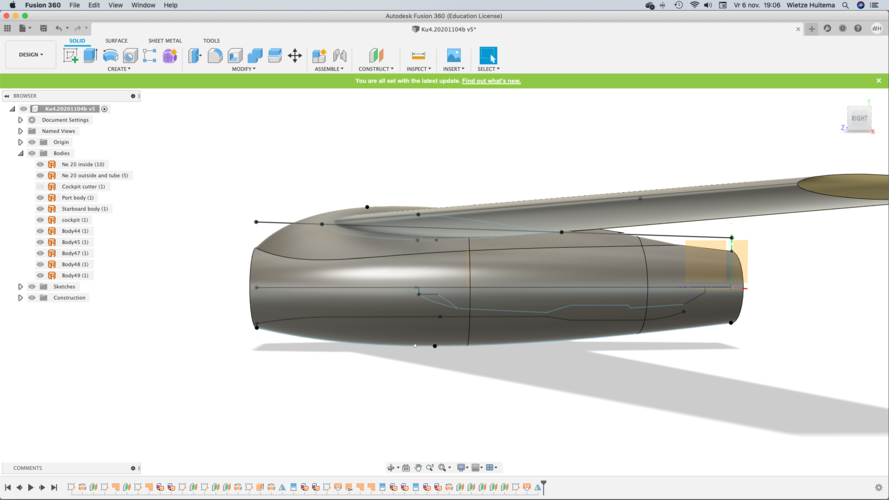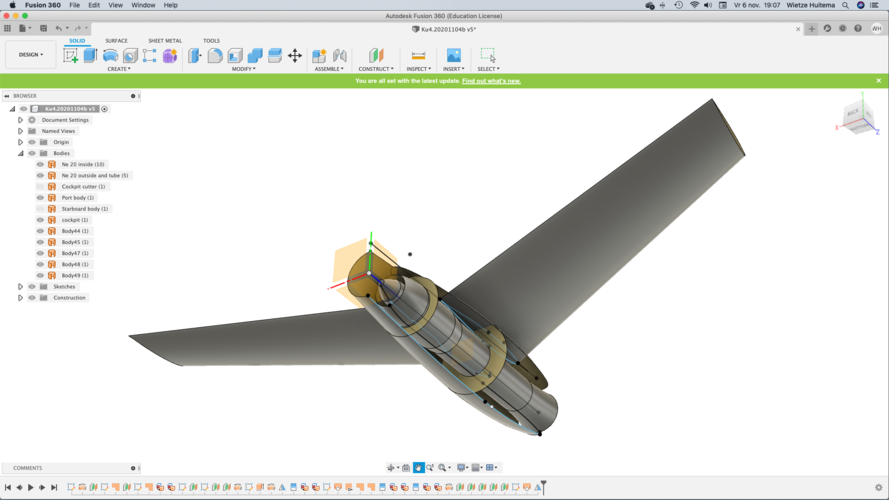Kayaba Katsuodori
Despite their appearances, the short range of the airplanes powered by rockets seriously hindered its military use. The logical alternative was to favour the development of the turbojet to achieve more reliable and powerful engines. Unfortunately, the Japanese industry was not able to produce the required metallic alloys, especially resistant to heat and stress. They lacked metals like chromium and molybdenum that were essential to harden the steel.
But the advanced materials for the compressor blades of the turbojets would not be ready on time and everyone was aware of it. The
Maru Ka-10 pulsejet did not have power enough and it was soon made evident that they were a death end. The vibrations they generated were destructive to the airplane structure. The situation demanded a new type of engine capable of running on any fuel and easy to build with cheap metals, so the Japanese aircraft industry was forced to consider the use of ramjets.
The theory elaborated by René Lorin in 1913 established that this type of engines produced the maximum thrust at Mach 2, but the theoretical work carried out in Germany by Dr. Eugen Sänger in 1940 showed that a ramjet built with length/diameter ratio of 5 to 1 could work in the high subsonic speed range, with lower specific fuel consumption than a rocket and higher thrust than a turbojet.
In the forward conical portion of the engine, the air flow will be decelerated with simultaneous pressure increase to approximately one-sixth of the flight speed. In the cylindrical combustion chamber the fuel is injected according to the throttling and mixed with the flowing air. At a speed above 200 kph the air inlet pressure is enough to start ignition using a ring of spark plugs, with the gases ejected from the jet pipe at a superior speed than that of flying. The first tests carried out in 1941 in the LFA-Volkenrode produced very long flames which discouraged wind tunnel test with ramjets. Ground test began in autumn 1941 with a prototype mounted above the Opel-Blitz truck.
In March 1942, a Sänger ramjet with 500 mm diameter was tested in flight, mounted above a Dornier Do 17 Z bomber, provided by the DFS-Ainring Institut. In December, a second test was carried out with a ramjet of 1,500 mm mounted above a Dornier Do 217 E-2. In the summer of 1944, the same airplane was used to test the final version of 1,000 mm. The ramjet worked correctly every time, although with low thrust due to the low speed of the bomber.
In theory, the Sänger 1000 had a nominal output of 17,400 hp, the Sänger 1,500 of 22,000 hp and the Sänger 2000 of 61,000 hp. But this could only be demonstrated by installing them on an aircraft capable of flying at a speed of Mach 0.8 and an altitude of 15,000 m. In January 1945 the DFS Institut issued a report suggesting the mounting of two Sänger 1000 above the wings of a Me 262 A-1. It was expected an increase of 200 kph in maximum speed, an increase of 4,000 m absolute ceiling and the reduction of the climbing time to 10,000 m from 26 to 6 minutes. The plan was thereby frustrated by the shortage of J2 fuel available for flying tests.
On 30 November 1944, the RLM requested the design of a ramjet propelled fighter. In December, the Oberammergau project bureau started working on a version of the Messerschmitt P.1101 powered by a Sänger 1000 in anticipation that the HeS 011 turbojet would not be ready on time. The modifications consisted in increasing the diameter of the fuselage, installing three fuel tanks of 1,500, 500 and 120 litres and designing a new landing gear whose main wheels would retract in tandem under the engine. The take-off was effected with the help of eight detachable RATO rockets of the Schmidding type 109-533, with 1,000 kp peak thrust each, which accelerated the aircraft to 120 m/sec. The new version was called Messerschmitt P.1101 L (
Lorinantrieb).
In December 1944, Professor Sänger designed the
Überschall-Staustrahljäger (supersonic ramjet fighter), a high-altitude interceptor of 7 tons propelled by a ramjet of 60,000 hp, but the DFS Institut lacked the facilities for its construction. In February 1945, the firm Skoda-Kauba Flugzeugbau-Cakowitz, who had carried out some discouraging experiments with foam coal ramjets, issued an order to the RLM for the design of an interceptor with ramjet propulsion based on the theoretical work of Sänger.
On 25 February 1945, the company produced the SK P14-01 design, a Mach 0.815 fighter powered by a Sänger 1500 with 22,000 hp nominal thrust, 1,000 litres of fuel, pilot in prone position, one MK 103/30 heavy cannon, landing skid and 10,000 m estimated absolute ceiling. The definitive design dated in April was the 7-tone SK P12-02, powered by a Sänger 2500 with 60,000 hp nominal thrust, 1,400 litres of fuel and 850 kph maximum speed. Take-off acceleration was provided by four Schmidding 109-533, mounted above a detachable tricycle trolley.
In March 1945, a Heinkel design team under the leadership of the Dipl.-Ing. Siegfried Günter, designed a high-altitude tailless interceptor named He P.1080, with a 15,100 hp Sänger 900 in each wing root, an armament of two MK 108/30 cannons and a maximum take-off weight of 3.325 kg. The P.1080 could fly for 90 minutes, with 1,100 kg of fuel, at an estimated maximum speed of 980 kph. The take-off was carried out from a detachable trolley propelled by four RATOG rockets Schmidding 109-533. The P.1080 was the last project developed by the firm during World War II.
In 1938 the Kayaba-Seisakusho Works Corporation was sponsored by the IJA Aero-Technical Research Institute (
Rikugun) to investigate the feasibility of tailless aircrafts. On January 1939 the HK-1 flew for the first time, a tailless glider with 25 degrees swept wing. The following prototype, the K2, had wingtips fins and flew by early November 1940. The K3 was a cranked rear swept flying wing with three pairs of control surfaces on the trailing edge. It was destroyed in 1941, unable to recover stability during a flat spin.
At that time Japan was already preparing for war and the IA cancelled the Kayaba programme to concentrate its efforts on the production of the Ki.43 and Ki.44 conventional fighters. In 1943 the IJA No. 2 Aeronautical Technology Research Institute, in collaboration with Kawasaki, built the Ne 0 ramjet engine based on the designs of the Sänger. The Ne 0 was 2.10 m long with a chamber combustion of 60 cm in diameter.
During ground tests conducted in July, the ramjet produced 60 kgf static thrust and at the end of that year was tested in suspended flight under the fuselage of a Kawasaki Ki.48-II bomber. Early in 1944, the IJA ordered to Kayaba the design of the
Katsuodori, a ramjet point interceptor powered by an advanced version of the Ne 0 with 750 kgf thrust.
The new engine, called Kayaba Model 1, had a combustion chamber one meter in diameter and could run with heavy kerosene or crude pine root oil that the local chemical industry produced as ersatz fuel. The
Katsuodori would have had a very similar airframe to that of the Heinkel P.1078 C German project of February 1944, with 35-degree rear-swept wings built in wood/plywood, with vertical fins in the wingtips, containing 2,000 litres of fuel. The circular fuselage would-be built of steel and contain the ramjet and cockpit with the in prone position.
The take-off was made on a detachable landing gear with the help of four Toku-Ro.1 Type 3 RATOG detachable rockets, with 600 kgf peak thrust and 20 seconds of life. The ramjet started at 367 kph and could run for 30 minutes. When the fuel ran out the
Katsuodori landed like a glider on a retractable skid and a tailwheel. Kayaba had planned to manufacture its own version of the Ho-301, 40 mm recoilless rocket-gun, modifying it to fire 30 mm rounds.
On July 1944 the IJA decided to cancel the
Katsuodori to concentrate on the manufacture of the Mitsubishi Ki.200 rocket fighter. To salvage the project, Kayaba adapted its design to accept the Ne 20 turbojet. The prototype was expected to be completed by the end of 1944, but the award of Ne 20 to the
Kikka programme forced its final cancellation.
Kayaba
Katsuodori technical data
Wingspan: 8.99 m, length: 4.48 m, height: 1.85 m, wing area: 12.57 sq.m, max weight: 3,000 kg, max speed: 900 kph, service ceiling: 15,000 m.
























![Kayaba_KatsuoDori 3 side[1].jpg](/data/attachments/80/80331-0d4dcc78b79842325bb13b5949d06127.jpg)



















